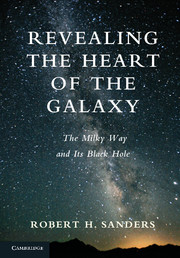Book contents
- Frontmatter
- Contents
- Acknowledgements
- 1 Introduction: The Luminous Pathway
- 2 The Discovery of the Milky Way Galaxy
- 3 The New Physics
- 4 Parting the Veil with Radio Astronomy
- 5 The Violent Universe
- 6 New Windows on the Galactic Center
- 7 The Milky Way as a Barred Spiral Galaxy
- 8 The Evolving View of Active Galactic Nuclei
- 9 The “Paradox of Youth”: Young Stars in the Galactic Center
- 10 Stellar Orbits in the Galactic Center, QED
- 11 Black Holes Here, Black Holes There…
- 12 Traces of Activity: Past, Present, and Future
- 13 After Words: Progress in Astronomy
- References
- Index
11 - Black Holes Here, Black Holes There…
Published online by Cambridge University Press: 05 December 2013
- Frontmatter
- Contents
- Acknowledgements
- 1 Introduction: The Luminous Pathway
- 2 The Discovery of the Milky Way Galaxy
- 3 The New Physics
- 4 Parting the Veil with Radio Astronomy
- 5 The Violent Universe
- 6 New Windows on the Galactic Center
- 7 The Milky Way as a Barred Spiral Galaxy
- 8 The Evolving View of Active Galactic Nuclei
- 9 The “Paradox of Youth”: Young Stars in the Galactic Center
- 10 Stellar Orbits in the Galactic Center, QED
- 11 Black Holes Here, Black Holes There…
- 12 Traces of Activity: Past, Present, and Future
- 13 After Words: Progress in Astronomy
- References
- Index
Summary
Nearby, “Normal” Galaxies
In 1964 shortly after the discovery of quasars, George Field, then at Princeton, was impressed by the fact that the high redshift of quasars implied that they must be prevalent in the past – that very possibly they were associated with galaxy formation and not the end of a long process of galaxy evolution. He wrote a paper, now largely forgotten, entitled “Quasi-stellar radio sources as spherical galaxies in the process of formation.” This was before the popularity, or even the respectability, of the black hole scenario, so Field's picture was that a collapsing protogalaxy could form a dense spheroidal cloud in which star formation would be rapid. This would lead to a quasar luminosity and flux variations due to frequent supernovae. He even pointed out that the density of quasi-stellar sources could be consistent with the present observed density of spheroidal galaxies. In many ways this was a very prescient contribution, but now we know that the energy source is likely to be accretion onto black holes, and the black holes do not disappear. They remain in the center of most reasonably massive galaxies as a generally quiet quasar remnant (Lynden-Bell's idea), waiting there to flare occasionally when a morsel of food drifts by.
- Type
- Chapter
- Information
- Revealing the Heart of the GalaxyThe Milky Way and its Black Hole, pp. 149 - 164Publisher: Cambridge University PressPrint publication year: 2013



